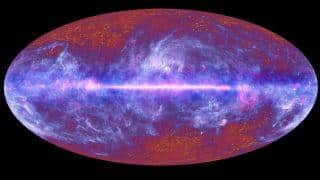As you begin to understand more about our Universe and learn of the millions of stars that are brighter than our Sun, you may begin to wonder, if stars are so bright and there are so many, why is space and our night sky dark? This contradiction is known as Olbers’ paradox.
Olbers’ Paradox: if the Universe is full of stars, why doesn’t the light from all the stars add up and make the sky bright?
This question comes from the thinking that if the Universe was infinitely old and infinitely big, then we would expect the sky to be bright from the light of all the stars at night how it is bright during the day. But all we have to do is wait until the Sun sets to know this is not true. So why is the night sky dark?
Table of Contents
The Infinite Universe Hypothesis
The concept of an infinite Universe led early astronomers to expect a bright sky. Yet, current evidence refutes this idea. Observations show the Universe is both finite and expanding, with a beginning we trace back around 13.8 billion years.
This expansion means not all light from distant stars can reach us. The finite age and size of the Universe help explain why night skies remain predominantly dark, countering the notion of infinite starlight filling the sky.
Solution to Olbers’ Paradox

There have been many proposed solutions to this paradox. The current best solution is breaking the assumption that the Universe is infinitely old. Astronomers find the Universe to only be 15 billion years old, and while this is a very long time to us, it is a mere fraction on the scale of infinity. How does the Universe having a finite age solve this paradox?
The Role of Dark Matter
Dark matter is another intriguing factor when considering why space appears dark. Though it makes up a large part of the Universe’s mass, dark matter does not emit or absorb light like stars.
Its presence can’t be observed directly through visible light, making it invisible to the naked eye. Even though it interacts with gravity, dark matter remains unseen and contributes to space’s overall darkness. By measuring gravitational effects on visible objects, astronomers infer its existence, further supporting our understanding of a dim Universe.
While light is one of the fastest things in the Universe it still takes time for it to get from point A to point B. With an infinitely large Universe there are stars so far away that even after 15 billion years their light has not yet reached us. If it has not reached us yet, then it cannot contribute to the brightness of our sky.
An additional explanation as to why space is dark is that the Universe is expanding, making stars and galaxies move away from each other. As the Universe expands, the light from galaxies gets stretched into different wavelengths. Some galaxies’ visible light may be stretched into wavelengths of nonvisible light such as radio waves, infrared, or microwaves.
The Doppler Effect and Redshift
The Doppler effect also plays a role in the darkness of space. As galaxies move away from us, their light stretches to longer wavelengths, known as redshift. This shift moves light out of the visible spectrum into infrared, making it invisible to our eyes.
As a result, many stars and galaxies do not contribute to the night sky’s brightness. While this light still exists, its new form is undetectable to us without special equipment, reinforcing the darkness we see.
While this is still light it is not visible light and therefore does not contribute to the brightness of our sky, and the sky remains dark. However, if you look at space in a different wavelength of light such as microwaves, space does glow. This is called the cosmic microwave background, which is the radiation left over from the Big Bang.

All sky image of the cosmic microwave background. Image Credit: ESA/LFI & HFI Consortia
Another contributing factor as to why space is dark is that space is nearly a perfect vacuum. If you recall our article on why the sky is blue you will remember that the Earth’s sky is blue due to the scattering of light with the molecules that make up our atmosphere. This scattering directs the light in all directions, including to our eyes.
Light Absorption by Cosmic Dust
Cosmic dust also plays a part in the darkness of space. These tiny particles scatter and absorb light from stars and galaxies before it reaches Earth.
By doing so, they further reduce the light visible from distant celestial bodies. Although the effect of cosmic dust is subtle, combined with other factors, it helps maintain the dark appearance of space. This scattering means that the paths of light particles are altered, diverting them away from direct lines to our eyes.
However, if there is nothing for light to scatter or interact with, it will travel in a straight line from its source to its receiver. Space is nearly a perfect vacuum which means it has extremely few particles in the space between planets, stars, and galaxies. There is almost nothing to scatter light to our eyes. So, unless there is a light source directed right at us, we do not receive the light. With no light reaching our eyes we see black.
If you are still a bit confused that is okay! Scientist have been studying this paradox for centuries. To help your understanding here is a great video explanation.
References:
- https://starchild.gsfc.nasa.gov/docs/StarChild/questions/question52.html
- https://www.livescience.com/why-does-space-look-black.html
- https://www.britannica.com/video/185566/energy-space-stars-night-sky
- https://www.space.com/33892-cosmic-microwave-background.html
- https://thehobbykraze.com/observational/astronomy/why-is-the-sky-blue/
Sharing is caring!


